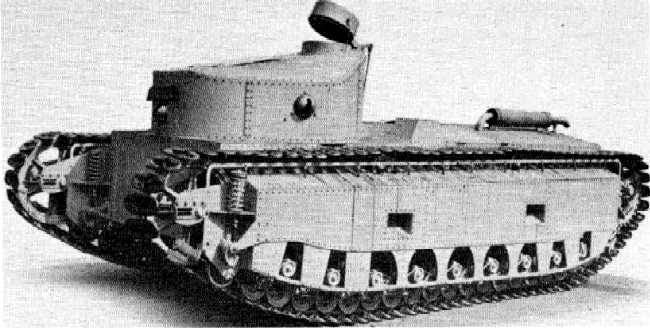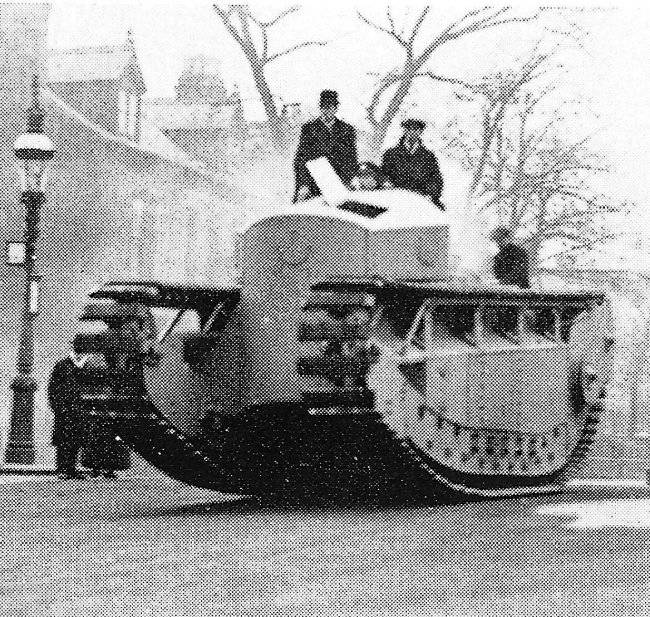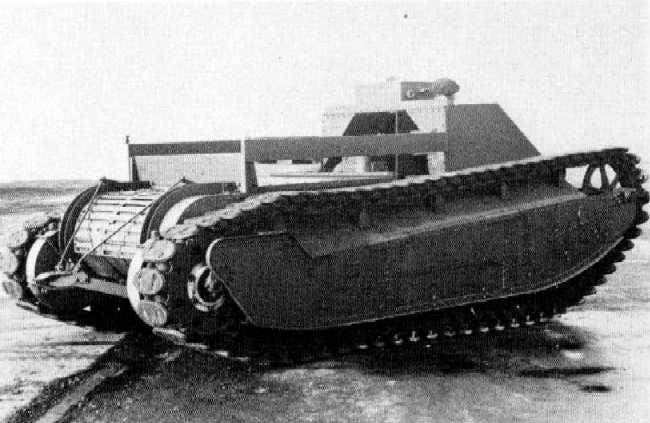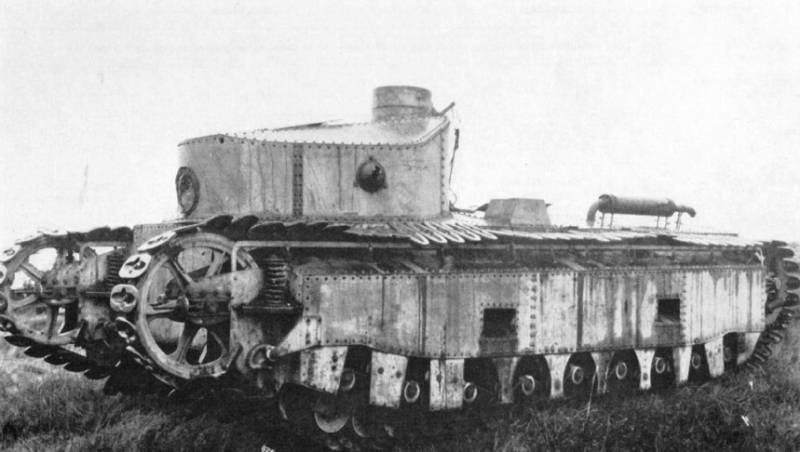Armored Light Infantry Tank and Light Supply Tank (UK)
In the early postwar years, the main light tank of the British army was the Mark A, also known as Whippet. This tank differed from other armored cars of its time with higher technical and operational characteristics, but by the beginning of the twenties it had become obsolete and needed to be replaced. In the middle of 1921, warlords attended to this problem and gave the appropriate instructions. Soon, the command of the Royal Tank Corps formed the requirements for a promising light tank, designed to replace the "Whippet".
Taking into account the experience in the development and operation of armored vehicles, the military department specialists issued a technical assignment for three cars at once, having some differences. The first of these was a light tank and was intended to accompany the infantry. With such tasks, she received the working designation Light Infantry Tank. The second armored vehicle was supposed to be operated in the colonies, which is why it was called Light Tropical Tank. The infantry tank should have been supplemented with the Light Supply Tank armored vehicle. All vehicles of the new family were supposed to have a relatively small mass of combat, high mobility, anti-bullet protection and machine gun weapons.

Experienced Light Tank Light Infantry Tank. No weapons
The existing Mark A light tanks did not fully meet the requirements of the time, which is why the military wanted to speed up the development of advanced equipment. This issue was resolved in a very interesting way. Shortly before the appearance of technical assignments for new armored vehicles, the tests of the Mark D medium tank were completed. This sample did not suit the military, but some of the ideas and solutions used to create it could be used in new projects. After analyzing the possibilities and prospects, it was decided to build the “Light Infantry Tank” and “Light Supply Tank” on the basis of the existing “D”.
Moreover, with a certain reservation, the new cars could be considered as variants of a deep modernization of the existing tank. In the framework of promising projects, it was actually proposed to change the dimensions of the armored vehicle in order to meet the new requirements, while the basic ideas of layout and other character remained the same. “Tropical” tank for the colonies, at the same time, decided to build without direct borrowing technical solutions from the project Medium Tank Mark D.
An additional way to accelerate the design and simplify future production was the maximum unification of the two machines. They had to have a common chassis with a unified body, power plant and chassis. All major differences related to the layout and equipment of the crew compartment. In addition, the two samples differed most noticeably in terms of the range of tasks to be solved. The direct support of the infantry was assigned to Light Infantry Tank, whereas Light Supply Tank was in fact a carrier of ammunition.
Two new cars were proposed to be built on a unified chassis, which was a smaller version of the rejected Mark D medium tank. While keeping the transverse dimensions at the same level, the hull was shortened, which also led to the chassis reworking. This led to a decrease in combat mass and allowed the use of a less powerful engine. In addition, the resulting stock of the landing gear carrying capacity was used to increase some armor.
The unified hull of two armored vehicles was assembled with bolts and rivets on the frame and had protection in the form of rolled sheets no thicker than 14 mm. The layout was based on the ideas of the previous project. The front of the hull stood out under the habitable compartment with all the crew jobs. Behind the fighting compartment was a large compartment for the engine, transmission, fuel tanks, etc. The hull had large on-board units that were inside the tracks and had fastenings for installing the necessary undercarriage devices.
The new hull of reduced dimensions had a vertical front leaf, on the sides of which external beams were mounted to install part of the suspension elements. Behind the frontal sheet, the hull expanded, forming niches inside the tracks. Under such niches there were mounts for pendants and rollers, in a checkerboard pattern, covered with armor plates. The front part of the roof of the “Light Infantry Tank” had a curved shape and was intended for installation of a deckhouse. The stern of the hull was equipped with a horizontal roof. Depending on the type of vehicle, the chassis could have inclined or rounded stern sheets.

The prototype of the medium tank Mark D
The Light Infantry Tank armored vehicle received a wheelhouse similar to that used in the Medium Tank Mark D project. It had a curved frontal sheet, to which side parts of similar shape were attached. The stern leaf was distinguished by its increased height, due to which the cabin received a curved roof tilted forward. In the stern of the upper sheet there was an opening for the installation of a turret with a hatch and viewing slots.
The “light supply tank” received a superstructure of a less complex form. In the frontal part of its hull it was proposed to place an armored trapezoidal profile. She had a sloping frontal sheet, vertical sides and a horizontal roof. In the center of the roof was provided a small rectangular turret with viewing devices.
It was proposed to equip the chassis of the Light Infantry Tank and Light Supply Tank machines with a Hall-Scott petrol engine with a 100 hp. Through a mechanical transmission of an uncomplicated design, the engine was connected with stern driving wheels.
The undercarriage was used, which was a reduced and revised version of the system from Project D. On each side of the board, with the help of a interlocked spring suspension, 22 small-diameter track rollers were attached. On the bases made in the front of the hull were placed the guide wheels, in the stern - leading. The upper branch of the caterpillar lay on several supporting rollers and special rails. In two new projects, the caterpillar was again used. skeletal structure. Directly with the rollers and the wheels interacted a metal chain of small width, to which the transverse tracks were attached. To improve traction and mass distribution, tracks could swing relative to the chain.
The armored cabin of the Light Infantry Tank received three embrasures with installations for mounting machine guns. The front sheet had a larger installation, which, according to some sources, could carry two machine guns at once. Two more similar devices under one machine gun each were placed on the sides. Armament of the tank consisted of three or four Hotchkiss machine guns caliber 7,7 mm. Placing machine guns in three installations, borrowed from the previous draft of the medium tank, allowed us to simultaneously attack several targets in different directions. Some sources claim that the Light Infantry Tank tank did not have a deckhouse, but a turning tower, but this information is not sufficiently confirmed.
The machine Light Supply Tank was not intended for direct execution of combat missions, but had weapons for self-defense. In the front sheet of its cabin there was a ball machine for mounting one machine gun rifle caliber. With his help, the crew could defend against the enemy infantry, but the attack of any serious targets, for obvious reasons, was excluded.
The main task of the “Light supply tank” was the transportation of ammunition and various materiel needed by the troops during the battles. For the transportation of the payload it was proposed to use an open cargo platform. Almost the entire rear part of the hull roof, which was located behind the cabin of the crew, was a platform for the placement of certain goods. In order to avoid loss of cargo during movement, the site received side barriers of a simple construction. Convenience of loading and unloading was proposed to provide with the help of a rounded unit with flooring, placed at the junction of the roof and the stern sheet.
The crew of the infantry tank consisted of five people. All tankers were located in a single volume, which served as the department of control and combat compartment. In front of the compartment were a driver and his assistant. They could use roof hatches. To observe the road there were viewing gaps. The crew also included two arrows and a commander. The latter was located in the aft compartment and could follow the terrain with the help of the observation slots of its turret. The latter was equipped with a hatch. Two arrows could use any available machine guns. Apparently, if necessary, an assistant driver and a commander could play the role of machine-gunners, which made it possible to simultaneously use the entire available weapon system.
Exact information about the composition of the crew of the supply vehicle is not available. Probably, she could be controlled by a driver and his assistant, as well as a shooter. This allowed to operate the machine and, if necessary, engage in self-defense. Access to the habitable compartment was provided by a sunroof.
Projects Light Infantry Tank and Light Supply Tank meant significant reworking of the existing Mark D chassis, aimed at reducing the size of the equipment in accordance with new customer requirements. This task was successfully solved. Both armored vehicles had a length of just over 6,7 m with a width of less than 2,2 m and a height of no more than 2,8 m. The combat weight of both samples reached 17,5 tons. At the same time, the transport armored vehicle could take on board up to several tons of various cargoes. Despite the low power density, both cars had to reach a speed of at least 30-35 km / h on the highway. There was the possibility of overcoming various obstacles. According to some data, the volumetric hull made it possible to swim, but the reserve of buoyancy left much to be desired.
Redesigning an existing project, despite its complexity, took only a few months. Due to this, the design documentation for two prospective armored vehicles for various purposes was prepared already in 1921 year. In the last months of the year, the assembly of prototypes began. For each project, one prototype was built. Soon, two cars took to the landfill and demonstrated their potential.
Estimated running performance has been confirmed. "Infantry tank" and "Supply Tank" showed acceptable mobility. Thus, the use of the original chassis, which was originally created to increase patency, again justified itself and allowed to obtain the required capabilities. From the point of view of firepower, Light Infantry Tank hardly differed from the base Medium Tank Mark D, which had a similar combat compartment design and similar weapons. Light Supply Tank, in turn, could carry large loads, primarily ammunition, etc.

Transport vehicle Light Supply Tank, view of the stern. Clearly visible cargo area
However, both armored vehicles had noticeable problems. In the first place, they differed from other modern machines in greater complexity of design. Because of this, the assembly and operation of equipment were associated with certain difficulties, and also differed by increased cost. From the point of view of labor-intensiveness and prices, the new light armored vehicles did not look very successful compared to other developments in its class.
After examining the pros and cons of the two samples, the command of the UK tank corps decided not to adopt them. Too complicated and expensive tank and transport vehicle did not represent a real interest for the troops. After this decision, the project was closed for lack of prospects. Two prototypes for some time remained in storage, but subsequently went for recycling. The further development of the British armored vehicles was now carried out in the framework of other projects.
The projects of the Light Infantry Tank and Light Supply Tank cars were intended for the quick renewal of the armored vehicle fleet. At the same time, “Light Infantry Tank” was a replacement for the aging Mark A Whippet, and “Light Tank Supply” turned out to be the first member of his class, able to significantly increase the mobility of troops and optimize their supply. To speed up the development of new projects, it was proposed to use existing ideas and solutions in the most active way. It really allowed to reduce the design time, but led to other characteristic problems.
One of the reasons for the abandonment of the Medium Tank Mark D medium tank was the excessive complexity of the design, primarily the undercarriage. In the course of completion in the framework of new projects, the existing chassis was reduced and seriously changed in accordance with the current requirements of the customer. A direct consequence of this was the preservation of almost all of the existing problems associated with the high complexity of the suspension and the tracks. Thus, the reconstructed design first led to the abandonment of the medium tank, and then "destroyed" two light-duty cars.
In 1920-21, British engineers were involved in the development and processing of the Medium Tank Mark D project. The first results of this work were two options for upgrading the basic design. Subsequently, on the basis of an average tank, two light vehicles were developed for various purposes. All these projects did not advance further to the ground tests, and the army did not receive these types of armored vehicles. After the closure of the projects Light Infantry Tank and Light Supply Tank, the development of the existing high-end chassis stopped. The following British tanks were based on different ideas and solutions.
Based on:
http://aviarmor.net/
http://mailer.fsu.edu/
Fletcher D. The British Tanks 1915-19. The Crowood Press, 2001.
Fedoseev S. Tanks of the First World War. - M .: Yauza: Eksmo, 2010.

Information